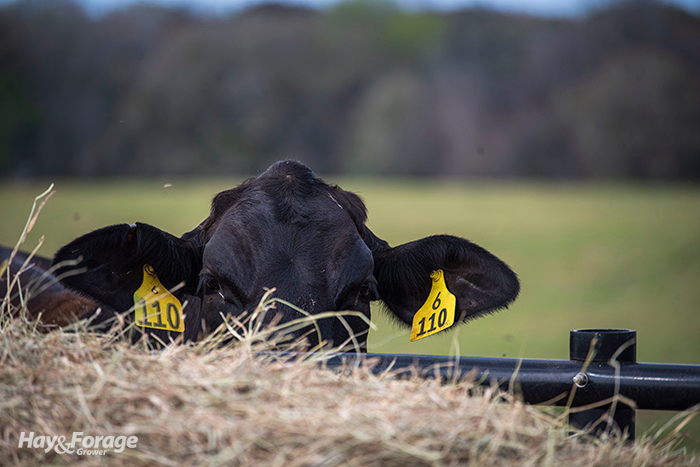
Whenever hay prices are put under the microscope, it’s important to acknowledge the interacting factors that influence the cost. For one, hay prices are largely regional and driven by local weather, water availability, hay stocks, and competitively priced commodities.
The livestock that consume the hay play a large role in hay prices, too. That includes livestock species, market prices, and the direction of the livestock industry as a whole. To unpack this relationship further, Josh Callen compared the current state of the nation’s beef market to that of the hay market in last week’s Hoyt Report.
Although the Western hay market analyst admits cattle are not his area of expertise, Callen is privy to the effects they can have on hay prices. “A common question I get is whether high cattle prices will allow ranchers to afford more feed and, in turn, help support hay prices,” Callen writes. “My answer has been, ‘yes and no.’”
In addition to high cattle prices, precipitation patterns matter, and Callen says dry conditions are currently affecting a large swath of the western U.S. Many ranchers there are pulling cattle off of pastures and rangeland to feed hay earlier than normal this year.
“As you’ll remember, the drought conditions of 2021 and 2022 helped set the stage for record-high hay prices during those years,” Callen writes. However, cattle prices were not as high back then, and many farmers chose to reduce their herd size to cover feed costs. Even though that might not be the case this time, maintaining relatively stable demand, Callen purports some operations have not fully recovered and still have fewer mouths to feed.
Rainfall across the rest of the country can affect regional hay prices, too. Callen suspects adequate rainfall across the Midwest — especially the Upper Midwest — has boosted hay supplies in those states. Although he predicts quality-sensitive buyers will continue to source hay from the West, many Midwestern farmers may opt for more locally available feed.
On a more anecdotal note, Callen shares that as many Western farmers and ranchers reach retirement age, they may be more interested in selling their animals to take advantage of once-in-a-lifetime cattle prices. The question then becomes: Are these heifers and cows staying in the breeding pipeline? And if so, what will it cost to feed them?
Weighing the options
Feed costs are often cited as the largest expense on a beef producer’s balance sheet. Considering the state of the cattle market, Kenny Burdine with University of Kentucky Extension analyzes whether it’s more profitable for farmers to develop their own replacements or sell weaned calves at record-high feeder cattle prices and buy bred heifers.
“It is not uncommon for someone to comment on how expensive bred heifers are and assume that they can develop their own heifers for much less,” the livestock marketing specialist writes in a Cattle Market Notes newsletter. However, he contends that the costs of doing so can add up quickly, highlighting three factors that will be key in the decision.
Opportunity costs. The biggest cost of developing a heifer is the opportunity cost of not selling a weaned calf. Burdine estimates that a 500- to 600-pound weaned heifer is currently valued at $2,000 across most of the U.S. “This cost is huge right now due to the strength of the calf market and higher interest rates, which makes forgoing that income even more significant,” he states. Burdine adds that while the heifer herself is the easiest cost to quantify, the total opportunity cost also accounts for the value of hay, pasture, breeding, facilities, and labor.
No guarantees. Not all replacement heifers will make the cut, though. Whether that is because a heifer fails to get bred or just doesn’t meet the expectations of a farmer, it will then be sold as a feeder animal, which likely won’t cover the costs of raising it.
“After the initial cost of not selling the heifer at weaning, another year of expenses will be incurred to get that heifer to the same stage as those bred heifers on the market,” Burdine says. This includes costs associated with winter feeding, summer grazing, and time and labor spent caring for livestock up to this point.
Bullish calf prices. With that said, Burdine suggests 2026 will likely be a profitable year for cow-calf operations, so buying bred heifers instead of developing them could pencil out to a quicker return on investment. For example, bred heifers on the market right now should wean a calf next fall. On the other hand, a spring-born heifer calf weaned today and kept as a replacement wouldn’t wean her first calf until the fall of 2027.
“The potential profit on that calf in 2026 becomes capitalized in the value of those bred heifers in 2025,” Burdine explains. “For this reason, comparing the cost of a bred heifer in fall 2025 to the cost of developing a heifer weaned in fall of 2025 can be misleading.”
Overall, he suggests there are advantages to either approach — it ultimately comes down to the goal of the farmer. In addition to his cost-benefit analysis, there are factors at play beyond the economics, so considering all of the moving parts in your operation will be necessary to make the best decision.

